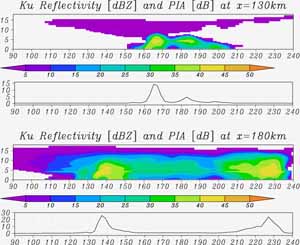Satellite Data Simulator Unit (SDSU)
SDSU ver. 2.1.4 is now available
(released on June 27, 2011).
1. Overview
 This package contains Fortran codes to simulate microwave brightness
temperature, radar reflectivity, and visible/infrared radiance as
measured by meteorological satellite sensors.
The three simulator components aimed at microwave radiometers, radars, and
visible/IR imagers can be executed either individually or all together.
Radiative transfer codes are implemented with Mie-theory-based subroutines to
compute the radiative properties of cloud and precipitating hydrometeors
as well as a gas absorption database covering a broad range of electromagnetic
spectrum.
A beam-convolution program is also provided so that the non-uniform beam
filling effect is taken into account for an arbitrary FOV size.
This package contains Fortran codes to simulate microwave brightness
temperature, radar reflectivity, and visible/infrared radiance as
measured by meteorological satellite sensors.
The three simulator components aimed at microwave radiometers, radars, and
visible/IR imagers can be executed either individually or all together.
Radiative transfer codes are implemented with Mie-theory-based subroutines to
compute the radiative properties of cloud and precipitating hydrometeors
as well as a gas absorption database covering a broad range of electromagnetic
spectrum.
A beam-convolution program is also provided so that the non-uniform beam
filling effect is taken into account for an arbitrary FOV size.
The existing and prospective satellite sensors applicable include
(but are not limited to):

- Microwave radiometers and sounders*1
- Special Sensor Microwave/Imager (SSM/I)
- Tropical Rainfall Measuring Mission (TRMM) Microwave Imager (TMI)
- Advanced Microwave Scanning Radiometer (AMSR) and AMSR-E
- Coriolis WindSat
- Global Precipitation Measurement Mission (GPM) Microwave Imager (GMI)
- Advanced Microwave Sounding Unit (AMSU) and Microwave Humidity
Sounder (MHS)
- Radars
- TRMM Precipitation Radar (PR)
- CloudSat Cloud Profiling Radar (CPR)
- GPM Dual-frequency Radar (DPR)
- Visible and infrared imagers
- Advanced Very High Resolution Radiometer (AVHRR)
- TRMM Visible/Infrared Scanner (VIRS)
- Moderate Resolution Imaging Spectroradiometer (MODIS)
- Visible/IR sensors onboard operational geostationary satellites
such as GMS (MTSAT), GOES, and Meteosat.
SDSU gallery shows some sample simulations.
[*1: A minor modification to the radiative
transfer code will be needed to simulate mixed polarization channels,
typical of cross-track scanning sounders.]
2. SDSU version 2
The SDSU is now upgraded to version 2.
Major changes from the earlier version are

- The entire code has been rewritten in Fortran 90.
- New user interface is supported to customize the hydrometeor
particle size distributions (PSDs) incorporated in the simulator.
- The PSD library currently consists of 9 PSD models including
exponential, gamma, modified gamma, and log-normal distributions.
Users can even create their own PSDs to add to the library.
- Computational efficiency has been dramatically improved for the
visible/IR simulator with Mie lookup tables (LUTs).
The Mie LUT option now works with all the three simulator components.
- The User's Guide is available for the SDSU-v2 (see section 4 below).
The latest version as of April 19, 2011 is SDSU 2.1.4
(see Release Notes for more information).
3. Download
3.1 Package
Please visit the download page
to get the latest version of the SDSU package.
3.2 Patch archives
Patches are available for existing users to upgrade their SDSU.
Patches don't work with SDSU ver.1, so if you don't have SDSU-v2
yet, please visit the registration portal above.
The patch archives will be kept updated for future upgrades.
Existing SDSU-v2 users are encouraged to regularly check the SDSU
www site.
Expand the downloaded patch in your "SDSU-v2/" directory
and follow the instructions in README.
4. Documentation
The SDSU-v2 User's Guide in PDF,
revised on May 21, 2010 for ver. 2.1.2 (document release 2.1),
is the complete documentation of the SDSU version 2.
A short SDSU article has been published in the In Box section of Bulletin of
the American Meteorological Society (BAMS), 91,1625-1632 (2010)
[PDF].
5. Feedback
Please send questions, bug reports, complaints, or whatever responses
to Hiro Masunaga,
Nagoya University.
Since it is maintained on a volunteer basis, prompt reply is not guaranteed.
 This package contains Fortran codes to simulate microwave brightness
temperature, radar reflectivity, and visible/infrared radiance as
measured by meteorological satellite sensors.
The three simulator components aimed at microwave radiometers, radars, and
visible/IR imagers can be executed either individually or all together.
Radiative transfer codes are implemented with Mie-theory-based subroutines to
compute the radiative properties of cloud and precipitating hydrometeors
as well as a gas absorption database covering a broad range of electromagnetic
spectrum.
A beam-convolution program is also provided so that the non-uniform beam
filling effect is taken into account for an arbitrary FOV size.
This package contains Fortran codes to simulate microwave brightness
temperature, radar reflectivity, and visible/infrared radiance as
measured by meteorological satellite sensors.
The three simulator components aimed at microwave radiometers, radars, and
visible/IR imagers can be executed either individually or all together.
Radiative transfer codes are implemented with Mie-theory-based subroutines to
compute the radiative properties of cloud and precipitating hydrometeors
as well as a gas absorption database covering a broad range of electromagnetic
spectrum.
A beam-convolution program is also provided so that the non-uniform beam
filling effect is taken into account for an arbitrary FOV size.

